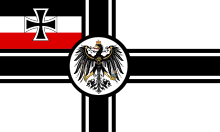SMS G39
| |
| History |
 German Empire German Empire |
| Ordered: |
1914 Peacetime order |
| Builder: |
Germaniawerft, Kiel, Germany |
| Launched: |
16 January 1915 |
| Commissioned: |
20 August 1915 |
| Fate: |
- Interned at Scapa Flow 22 November 1918
- Scuttled at Scapa Flow 21 January 1919
|
| General characteristics |
| Displacement: |
1,051 tonnes |
| Length: |
79.5 meters |
| Beam: |
8.33 m |
| Draft: |
3.74 m (fwd); 3.45 meters (aft) |
| Speed: |
34.5 knots (63.9 km/h) |
| Range: |
- 1,100 nautical miles at 20 knots
- (2,040 km at 37 km/h)
|
| Complement: |
83 officers and sailors |
| Armament: |
- 3 × 88 mm guns
- 6 × 500 mm torpedo tubes
- 24 mines
|
SMS G39 was a Großes Torpedoboot 1913-class torpedo boat of the German Kaiserliche Marine during World War I, and the 15th ship of her class.
Construction
Built by Germaniawerft in Kiel, Germany, she was commissioned in August 1915. The "G" in G39 refers to the shipyard at which she was constructed.
Service
G39 was assigned to the High Seas Fleet of the Kaiserliche Marine when she participated in the Battle of Jutland. She served as the leader of the First Torpedo Boat Flotilla in this action under the command of Commander Conrad Albrecht. Admiral Hipper transferred from Lützow to G39 during the Battle of Jutland prior to his transfer to the Moltke.
After the end of hostilities, G39 was interned at Scapa Flow and scuttled.
One of the crew members on her last voyage was Leopold Bürkner, who later became head of foreign affairs intelligence during the Third Reich. He was interned until 29 January 1920.[1]
The boat was salvaged by Ernest Cox on 3 July 1925.
References
- Technical specs of the Großes Torpedoboot 1913 class
|
|---|
|
| Shipwrecks |
- 1 Jan: HMY Iolaire
- 21 Jan: UC-40
- 30 Jan: Nimrod
- 7 Feb: HMS Erin's Isle
- 8 Feb: U-16
- 10 Feb: UC-91
- 20 Feb: UC-71
- 22 Feb: U-21
- 7 Mar: HNoMS Thor
- 6 Apr: Vulkan
- 15 Apr: U-118
- 17 Apr: USS Freehold
- 27 Apr: USS Courtney, USS Otis W. Douglas
- 28 Apr: USS Gypsum Queen, USS James
- April (unknown date): Borets za Svobodu
- 5 May: SMS Leipzig
- 2 Jun: Rucumilla
- 18 Jun: Oleg
- 21 Jun: SMS Bayern, SMS Bremse, SMS Brummer, SMS Cöln, SMS Dresden, SMS Derfflinger, SMS Emden, SMS Friedrich der Grosse, SMS G38, SMS G39, SMS G40, SMS Hindenburg, SMS Grosser Kurfürst, SMS Kaiser, SMS Kaiserin, SMS Karlsruhe, SMS König, SMS König Albert, SMS Kronprinz Wilhelm, SMS Markgraf, SMS Moltke, SMS Prinzregent Luitpold, SMS S36, SMS S50, Scuttling of the German fleet in Scapa Flow, SMS Seydlitz, SMS V45, SMS V46, SMS Von der Tann
- 28 Jun: Duchess of Richmond
- June (unknown date): Erinpura
- 27 Jul: USS May
- 30 Jul: USS G-2
- 13 Aug: Basilicata
- 18 Aug: Dvina
- 1 Sep: HMS Vittoria
- 4 Sep: HMS Verulam
- 8 Sep: Valbanera
- 9 Sep: USS St. Sebastian, USS SP-471
- 10 Sep: USS Coco, USS Katherine K., USS Patrol No. 1, USS Sea Hawk
- 11 Sep: USS Helena I
- 29 Sep: ML-18, ML-62, ML-191, Ossifrage
- 30 Sep: August Helmerich
- 3 Oct: Frank O'Connor
- 7 Oct: Sizergh Castle
- 9 Oct: Daram
- 18 Oct: HMS H41
- 31 Oct: Fazilka
- 22 Nov: Myron
- 12 Dec: USS Kerwood
- 18 Dec: Cufic
- Unknown date: UB-14
|
|---|
|
| Other incidents | |
|---|
|
|